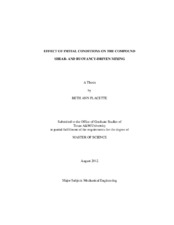| dc.description.abstract | The effect of initial conditions in combined shear- and buoyancy- driven mixing was investigated through the use of an implicit large eddy simulation code under active development at Los Alamos National Laboratory and Texas A&M University. Alterations were done over several months both at Los Alamos National Laboratory and at the Texas A&M University campus, and include a transition from tilted rig to convective channel arrangement, introduction of an inertial reference frame, alteration of boundary conditions, etc. This work resulted in the development of a numerical framework with the capability to model various shear and Atwood number arrangements such as those seen in an inertial confinement fusion environment.
In order to validate the code, it was compared to three published experiments, one with Atwood number 0.46 (White et al. 2010), one with high Atwood number 0.6 (Banerjee et al. 2010), and one with very low Atwood number 0.032 (Akula et al. 2012).
Upon validating the code, pure Rayleigh-Taylor and pure Kelvin-Helmholtz instabilities were modeled along with five intermediate cases of increasing shear and constant density gradient. Plots of mixing width, Richardson number, growth parameter, and molecular mixing were compared in order to determine at what level of shear the minimum amount of mixing occurs. The results of height gradient and Reynolds number were to previous experiments and theory.
The least amount of molecular mixing at the centerline was found to be when the system had a low Atwood number (0.032) and a multimode initial interface perturbation. While the increase in modes of the interface perturbation did not result in a significant change in the growth parameter, the level of molecular mixing at the centerline substantially decreased. As shear was increased in the system, the mixing width and molecular mixing subsequently increased. For this reason, the shear in the system should be eliminated, or at least minimized, if at possible so as to prevent any additional amalgamation in the system. Analysis of the Reynolds number revealed that with an increase in velocity difference between the fluid layers, the value consequently increased. This trend matches with theoretical results as the value is a function of the mixing width and velocity, thus further validating the code. Analysis of the transitional Richardson number revealed that it had a smaller value in the computational case over the experiment, but this fact can be attributed the difference in mixing width between the two methods. The development of the numerical framework with the capability to model various shear and Atwood number arrangements offers the platform for future study of hydrodynamic instabilities. | en |


